Abstract
Highly sensitive electrochemical biosensors for biogenic amine (BA) detection were developed using commercial screen-printed electrodes (SPEs) modified with a nanomaterial based on single-walled carbon nanotubes (SWCNT) and redox mediator, Prussian Blue (PB) and amine oxidase enzymes. The nanocomposite material enables an enhancement of the analytical performances for hydrogen peroxide detection, which represents the byproduct of the enzymatic oxidation of the BAs. The developed biosensors were integrated with a miniaturized potentiostate and a wireless data transfer interface in a portable system. The system was used for the detection of polyamines in soil solutions collected with a low-volume suction lysimeter.
1. Introduction
Biogenic amines (BAs) or polyamines are a group of chemical compounds that result from the biochemical degradation of amino acids in organisms [1,2]. The monitoring of BAs from the environment or from food and beverages is significant for global health due to their physiological effects on plants and animals [3]. BAs are involved in the growth and development of plants and increase the tolerance of plants to stress factors such as extreme heat, drought and salinity [4]. From BAs, putrescine, that results through arginine and ornithine’s decarboxylation, has been shown to be involved in plant development and to contribute to the increase in plant tolerance to abiotic stress [5,6]. The variation of the polyamines in plant soils occurs also when plants are affected by pathogens, because the microorganisms can develop mechanisms that lead to an increase in polyamine levels in plants [7].
Soil polyamines are potential markers for the evaluation of stress in plants and can help in the process of applying remediation measures in the agricultural field.
The traditional techniques used for BA detection and quantification are chromatographic ones, such thin-layer chromatography [8], gas chromatography coupled with mass spectrometry [9], reversed-phase high-performance liquid chromatography [10], ion chromatography [11] and capillary electrophoresis [12]. These techniques require bulky and expensive equipment, large volumes of sample and reagents, trained personnel and are time consuming. Electrochemical biosensors are promising alternatives for the detection of BAs due to their lower cost, miniaturization and portability, requiring small sample volumes non-specialized personnel to use them, are easy to use and offer the possibility of adaptation for on-site detection [13].
The general principle of biogenic amine detection using biosensors is based on hydrogen peroxide (H2O2) detection which results in the enzymatic oxidation process of the biogenic amines. Thus, in a first attempt, the biogenic amines are oxidized under the catalytic activity of amine enzymes, such as monoamine oxidase (MAO) [14], diamine oxidase (DAO) [15] or putrescine oxidase [16], with a concomitant reduction of flavin adenine dinucleotide and the formation of H2O2 as follows:

Further, the detection of hydrogen peroxide produced in the reaction can be performed through a direct reduction at the surface of unmodified electrodes, usually occurring at high overpotential values or by using a second enzyme, horseradish peroxidase (HRP).
Usually, the direct electron transfer to flavoenzymes is very difficult to be achieved since the FAD unit is deeply rooted in a protective coating of the enzymes (DAO or MAO). Nanomaterials based on carbon allotropes, such as carbon nanotubes, nanoribbons or nanowires have shown very good electrochemical communication with proteins having a redox center close to their surface.
Thus, enhancing the electrochemical performances for hydrogen peroxide detection represents an important aspect in the development of BA biosensors. Various nanomaterials [17] and redox mediators such as Prussian Blue [18] have been used to lower the applied potential for H2O2 reduction and to enhance the sensitivity.
Due to their advantageous structural and electrochemical properties, nanomaterials are used for the surface modification of working electrodes in the development of biosensors, in order to enhance their analytical performances [19]. Different nanocomposites based on graphene, multiwalled carbon nanotubes, metallic nanoparticles, polymers and redox mediators were reported in the literature for the electrochemical detection of biogenic amines [20,21,22,23,24].
This paper describes the development of amperometric biosensors for putrescine and histamine detection in soil solution using a portable miniaturized system. The sensitive and selective biosensors were obtained through immobilization of DAO and, respectively MAO onto the SPEs modified with nanocomposite material based on SWCNT and PB redox mediator. The developed biosensors for polyamine detection were integrated with a SCADA (Supervisory Control and Data Acquisition)-type interface in a portable system and their functionality was demonstrated in real samples of soil solution extracted with a low-volume suction lysimeter.
2. Materials and Methods
2.1. Reagents
Sodium phosphate dibasic dehydrate (Na2HPO4·2H2O), potassium phosphate monobasic (KH2PO4), potassium chloride, sodium acetate, hydrochloric acid (HCl), low-molecular-weight chitosan (MW = 50–190 kDa), Pt nanoparticles (PtNP), potassium ferricyanide (K4Fe(CN)6), ferric chloride (FeCl3), tetraethyl orthosilicate (TEOS), methyltriethoxysilane (MTEOS), polyethylene glycol 550 monomethyl ether (PEG550), diamine oxidase from pork liver (DAO, EC 1.4.3.22.), histamine and putrescine were purchased from Sigma-Aldrich. Monoamine oxidase (MAO) (EC 1.4.3.4) was provided by Abcam, Cambridge, UK. The single-walled carbon nanotubes (SWCNT) were supplied by Carbon GmbH, Bayreuth, Germany. For the electrochemical measurements, acetate buffer 0.1 M, pH 5 and, respectively, phosphate buffer 0.1 M, pH 6.0–9 solutions were used. All aqueous solutions were prepared using ultrapure water obtained with Millipore Integral5 (18.25 MΩ·cm).
2.2. Electrochemical Measurements
The electrochemical studies were carried out using a µStat 4000 Potentiostate/Galvanostate, while the Drop View 8400 software was used for data acquisition and analysis. Commercial screen-printed electrodes SPE (DRP-110) on ceramic and PVC supports were obtained from Dropsense, having a three-electrode configuration, where the working (4 mm diameter) and counter electrodes are made of carbon and the reference one is a silver pseudo-reference electrode.
All the measurements were performed at room temperature, and all potentials were referred to the Ag pseudo-reference electrode.
The morphological studies were carried out with a Hitachi TM4000plus II (Hitachi, Chiyoda City, Tokyo, Japan) scanning electron microscope.
The spectrophotometric assays of the enzymatic kinetics were performed with a NanoDrop-OneC spectrophotometer (Thermo Scientific, Waltham, MA, USA).
2.3. Design and Development of the Miniaturized and Portable Detection System
After the elaboration of the experimental model for the polyamine determination in soil solution, our partner, SYSWIN SOLUTIONS (Bucharest, Romania) has elaborated the experimental model for the electronic interface and data transfer system, in order to design the portable system for monitoring polyamines in the field. The new miniaturized detection system was designed using a specialized ADuCM355 circuit board, which facilitates low-current detection (±50 pA ± 3 mA) integrated with an EmStat pico PalmSens module for carrying out potentiostatic measurements. The miniaturized detection system designed for the electrochemical detection of BAs was provided with an electronic display for registered data and with a wireless data transfer system. The data transfer was achieved using wireless NB-IoT (Narrowband Internet of Things) technology [25] and the process was optimized for the B20 (800 MHz) frequency band, which can facilitate data transfer up to a 18–21 km radius without any intermediary devices. The schematic representation of the experimental model is shown in Figure 1.
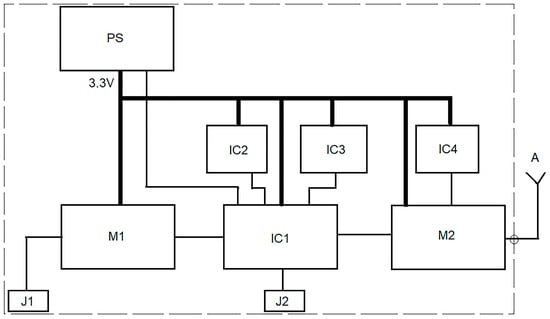
Figure 1.
Schematic representation of the experimental model: M1: EmStat pico module with ADuCM355 microcontroller; M2: Multi-Band NB-IoT module; IC1: Low-Power, 32-bit Cortex-M0+ microcontroller; IC2: 3-Axis digital accelerometer; IC3: 32Mbit serial flash memory; IC4: Embedded subscriber identity module; PS: power supply; J1: USB connector; J2: DS1020-03ST1D connector; A: antenna.
For a facile insertion of the developed biosensors in the low-volume suction lysimeters used to collect the solution from the plant soil, an adaptor was designed and manufactured by 3D printing, allowing for the connection of the SPEs to the acquisition board of the detection system. Thus, the experimental model is composed of the BA biosensor, the data acquisition board containing the integrated potentiostate module, the wireless communication module and a software application for acquisition, displaying and analyzing the registered data.
2.4. Preparation of Electrochemical Sensors and BAs Based Biosensors
The electrochemical sensors based on SWCNT and PB were obtained by simple drop casting of 10 μL of a mixture containing 2 mg/mL SWCNT and redox mediator PB on the surface of the working electrodes. The redox mediator was allowed to directly precipitate onto the single-walled carbon nanotubes, by mixing SWCNT with acidic solution of 0.1 M K3Fe(CN)6 and 0.1 M FeCl3, in a volumetric ratio of 1:1. Both solutions were prepared in 0.01 M HCl. The sensors were dried in an oven and kept at room temperature in the dark.
A sol–gel (SG) matrix was prepared by mixing TEOS and MTEOS precursors with PEG 550, ultrapure water and HCl 1 mM. After allowing a hydrolysis time at 4 °C, the sol–gel was formed and mixed with the enzyme DAO in a 1:1 volumetric ratio. The DAO-based biosensors were kept at 4 °C.
For the immobilization of the MAO, a polymeric matrix of chitosan was used. Thus, the MAO was mixed with a solution of CS prepared in acetic acid in a volumetric ratio of 1:1, and a volume between 2 and 20 μL of this mixture was drop cast onto the SWCNT-PB-based sensors.
3. Results
3.1. Characterization of Modified Electrochemical Sensors
Figure 2 shows the morphological structure of the unmodified SPEs and the sensors modified with SWCNT, PB, and, respectively SWCNT-PB. The images confirm the distribution of the nanomaterials on the sensor surfaces and a much more uniform dispersion of the SWCNT-PB layer compared to the other sensors. The roughness of the SWCNT-PB sensor surface is also much higher, inducing an increase in the surface electroactive area.
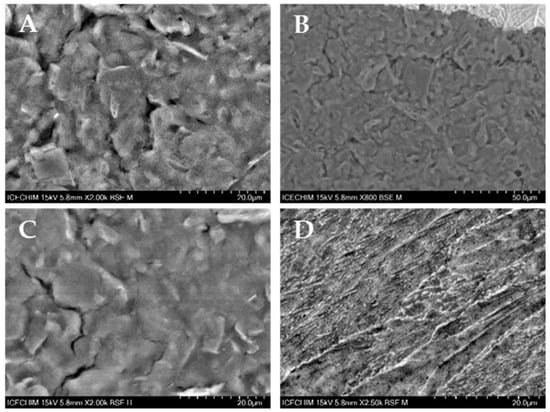
Figure 2.
Study of morpho-structural characteristics of the sensors functionalized with different materials: (A) SPE; (B) PB/SPE; (C) SWCNT/SPE; (D) SWCNT-PB/SPE.
Platinum nanoparticles were used in combination with SWCNT for the modification of SPEs in order to increase the electrocatalytic behavior towards hydrogen peroxide reduction. Therefore, the electrocatalytic reduction of hydrogen peroxide at the surface of the sensors modified with PB, SWCNT, SWCNT-PtNP and, respectively, SWCNT-PB was studied in 0.1 M phosphate buffer, pH 7, using different concentrations of hydrogen peroxide (Figure 3A,B).
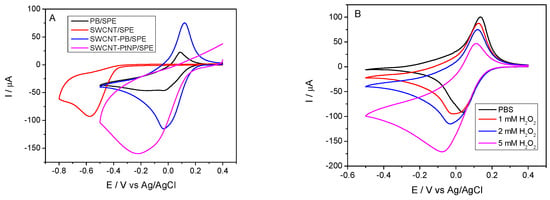
Figure 3.
Cyclic voltammograms recorded for the reduction of (A) 2 mM of H2O2 on PB/SPE-, SWCNT/SPE, SWCNT-PB- and SWCNT-PtNP/SPE-based sensors and (B) 1, 2 and 5 mM of H2O2 on SWCNT-PB/SPE (PBS 0.1 M, pH 7, 0.1 V/s).
As can be seen, a decrease in the cathodic peak potential values from −0.575 V for bare SWCNT/SPE to −0.028 V for SWCNT-PB/SPE was recorded, with formal redox potential values of 0.029 V for PB/SPE and 0.046 V for SWCNT-PB/SPE, respectively. An increasing of the anodic peak current to −116 µA was observed, corresponding to the H2O2 reduction at the surface of SWCNT-PB/SPE comparing to −30 µA registered at PB/SPE and, respectively, −91 µA using SWCNT/SPEs sensors.
Even if the SWCNT-PtNP-based sensors showed a relatively high current value of −128 µA for H2O2 reduction, the cathodic peak potential value of −0.22 V was much higher than that registered for SWCNT-PB/SPE. Thus, it was decided that SWCNT-PB/SPEs will be used in further studies in order for the development of biogenic amine biosensors.
Figure 3B shows the electrocatalytic behavior of SWCNT-PB based sensors towards the reduction of different concentrations of H2O2. An increasing of the cathodic peak current intensity was observed with the increase in the H2O2 concentration, from 91 µA in the presence of 1 mM H2O2 to 168 µA for 5 mM, with a simultaneous decrease in the anodic peak currents and a shift of the cathodic peak potentials towards more negative values, from −0.007 V to −0.076 V.
The SWCNT-PB-based sensors showed an enhanced electrocatalytic activity towards hydrogen peroxide reduction, by accelerating the electron transfer process at the sensor surface, by increasing the cathodic peak current intensity and lowering the reduction potential value, demonstrating in this way the excellent electrocatalytic activity of the nanomaterial towards H2O2 reduction. Thus, the sensors based on SWCNT-PB were used further in electrochemical studies for H2O2 detection and for biosensor development.
Amperometric detection of H2O2 was performed using SWCNT-PB/SPE sensors in 0.1 M acetate (pH 5) and phosphate (pH 6 to 9) buffer, at different applied potential values, in the range −0.05 to 0.05 V vs. Ag/AgCl. It was observed that the sensors modified with the SWCNT-PB nanomaterial achieves the highest sensitivity for H2O2 reduction at an applied potential of 0.05 V vs. Ag/AgCl in phosphate buffer 0.1M at pH 7, with a linear range extended up to 800 µM and a detection limit of 2.2 µM H2O2 (Figure 4).
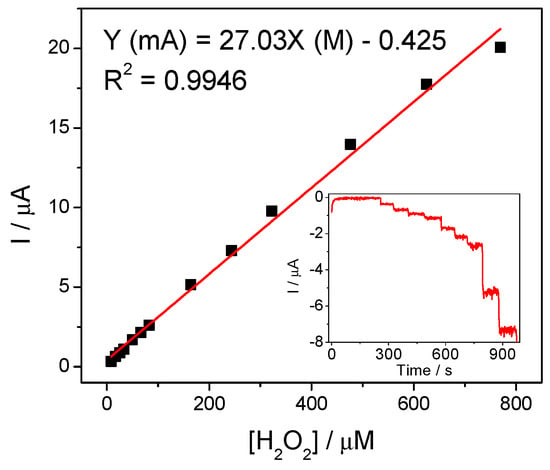
Figure 4.
Calibration of the SWCNT-PB/SPE sensor for the reduction of H2O2 (E = +0.05 mV, PBS pH 7). Inset: the current intensity vs. concentration of hydrogen peroxide.
The operational stability of the SWCNT-PB/SPE was estimated by performing successive amperometric measurements of the sensor response to 0.05 mM hydrogen peroxide. For 15 successive H2O2 additions in phosphate buffer 0.1 M, pH 7, at an applied potential of 0.05 V, the average current value was 1.354 ± 0.089 μA (RSD = 6.6%), proving the good operational stability of the developed sensors. The response time of the sensor for H2O2 was about 22 s.
3.2. Biosensors for the Detection of Biogenic Amines
The DAO-SG-SWCNT-PB/SPE-based biosensor was used for the amperometric detection of putrescine in the optimized conditions of 0.1 phosphate-buffered solution with pH 7.2 and an applied potential of 0.05 V (Figure 5).
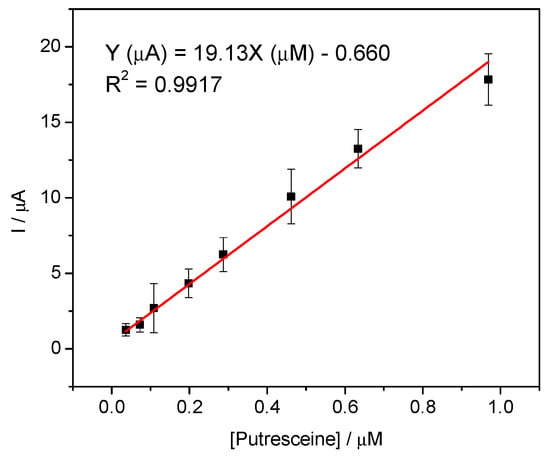
Figure 5.
Amperometric detection of putrescine using the DAO-SG-SWCNT-PB/SPE biosensor (applied potential 0.05 V vs. Ag/AgCl, PBS 0.1 M, pH 7.2). Inset: representation of current intensity dependence on putrescine concentration.
The developed biosensor demonstrated improved analytical performances for the detection of putrescine, such as a specific sensitivity of 153.7 mA∙M−1∙cm−2, a detection limit of 4.7 µM and a quantification limit of 15.5 µM, with a linear range extended from 0.02 and 1 mM. The value of the detection limit achieved for putrescine is lower compared to those reported for a DAO-based biosensors modified with PB and indium tin oxide nanoparticles (7.8 μM) [22] or with an MAO-based biosensor modified with tetrathiafulvalene and gold-nanoparticles (9.9 μM) [14].
Amperometric detection of histamine was carried out using MAO-based biosensors, obtained by immobilization of MAO on SWCNT-PB/SPEs through entrapment in chitosan polymeric matrix in 0.1 M PBS pH 9, at an applied potential of −0.05 V vs. Ag/AgCl. The MAO-CS-SWCNT-PB/SPE biosensor displayed a specific sensitivity of 6.25 mA∙M−1∙cm−2, a detection limit of 57 µM and quantification limit of 191 µM, with a linear range between 0.280 and 1.5 mM for histamine detection.
The DAO-SG-SWCNT-PB/SPE biosensors were used for the detection of putrescine content in soil samples used for the cultivation of ornamental plants in the laboratory. The soil solutions to be analyzed were extracted with lysimeters (Figure 6). The DAO-based biosensors were integrated with the developed miniaturized portable system, which allows for the collection and transmission of the data through a wireless connection, from several sampling points in the field.
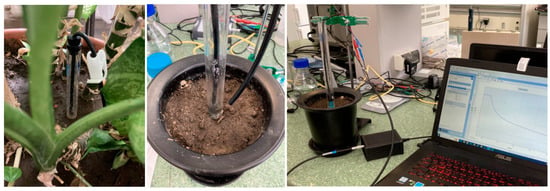
Figure 6.
Polyamine determination in soil using a portable detection system and an integrated DAO-SG/SWCNT-PB/SPE biosensor.
The experimental models were tested in laboratory conditions, the preliminary tests being performed in order to verify the measurement capability of the bioanalytical device, the response time for the detection of the target analyte, putrescine, and the calibration procedure. The experimental model was proven to be highly sensitive and to have a rapid response to the changes occurring in the solution.
Tests were carried out in real soil samples collected from the lysimeters, from soils with and without plants, and the measurements highlighted the sensitivity of the sensor for putrescine detection. Thus, the BA biosensors integrated with the portable miniaturized electrochemical detector represent a promising bioanalytical tool for biogenic amine monitoring in agricultural fields.
4. Conclusions
Sensitive and selective biosensors for biogenic amine detection were developed based on an SWCNT-PB nanocomposite material. The electrochemically developed sensors demonstrated a high sensitivity and low values of the applied potential used for H2O2 detection. The biosensors developed through the entrapment of DAO and, respectively, MAO enzymes in sol–gel and polymeric matrices were used for the amperometric detection of biogenic amines, putrescine and, respectively, histamine. Due to the good sensitivity obtained with DAO-based biosensors for putrescine detection, these biosensors were further integrated with a portable miniaturized potentiostate and wireless data transmission interface with the purpose of adapting the detection method to a wireless NB-IoT system for on-site monitoring of plant stress. The system was shown to be able to detect polyamines from soil solution collected with low volume suction lysimeters.
Author Contributions
Conceptualization, A.-M.G., L.-G.Z. and M.D.; methodology, A.-M.G., L.-G.Z., G.V. and M.D.; software, L.-G.Z., R.T. and G.V.; validation, M.L.J., M.C., I.R. and M.-L.J.; formal analysis, L.-G.Z., M.L.J. and C.F.; investigation, L.-G.Z., G.V. and A.-M.G.; resources, G.V. and A.-M.G.; data curation, A.-M.G., L.-G.Z. and M.L.J.; writing—original draft preparation, L.-G.Z. and A.-M.G.; writing—review and editing, A.-M.G. and M.D.; visualization, A.-M.G., G.V. and M.D.; supervision, A.-M.G. and M.D.; project administration, M.D. and G.V. All authors have read and agreed to the published version of the manuscript.
Funding
This work was funded by the grant of the Ministry of Research, Innovation and Digitization, CCCDI-UEFISCDI, project number PN-III-P2-2.1-PED-2021-1942, contract no. 662/2022–AMI-FOOD and by the project POC-A1-A1.2.3-G-2015-P_40_352-SECVENT, Sequential processes to close bioeconomy side stream and innovative bioproducts resulted from these, contract 81/2016, SMIS 105684, subsidiary project 2638/2022.
Institutional Review Board Statement
Not applicable.
Informed Consent Statement
Not applicable.
Data Availability Statement
Not applicable.
Acknowledgments
The authors gratefully acknowledge the support of Alexandrescu Elvira from ICECHIM for the SEM analysis of the modified sensors.
Conflicts of Interest
The authors declare no conflict of interest.
References
- Moinard, C.; Cynober, L.; de Bandt, J.-P. Polyamines: Metabolism and implications in human diseases. Clin. Nutr. 2005, 24, 184–197. [Google Scholar] [CrossRef] [PubMed]
- Zdolec, N.; Bogdanović, T.; Severin, K.; Dobranić, V.; Kazazić, S.; Grbavac, J.; Pleadin, J.; Petričević, S.; Kiš, M. Biogenic Amine Content in Retailed Cheese Varieties Produced with Commercial Bacterial or Mold Cultures. Processes 2022, 10, 10. [Google Scholar] [CrossRef]
- Wójcik, W.; Łukasiewicz, M.; Puppel, K. Biogenic amines: Formation, action and toxicity–A review. J. Sci. Food Agric. 2021, 101, 2634–2640. [Google Scholar] [CrossRef] [PubMed]
- González-Hernández, A.I.; Scalschi, L.; Vicedo, B.; Marcos-Barbero, E.L.; Morcuende, R.; Camañes, G. Putrescine: A Key Metabolite Involved in Plant Development, Tolerance and Resistance Responses to Stress. Int. J. Mol. Sci. 2022, 23, 2971. [Google Scholar] [CrossRef] [PubMed]
- Ahmad, A.; Aslam, Z.; Naz, M.; Hussain, S.; Javed, T.; Aslam, S.; Raza, A.; Ali, H.M.; Siddiqui, M.H.; Salem, M.Z.M.; et al. Exogenous salicylic acid-induced drought stress tolerance in wheat (Triticum aestivum L.) grown under hydroponic culture. PLoS ONE 2021, 16, e0260556. [Google Scholar] [CrossRef] [PubMed]
- Kovács, Z.; Simon-Sarkadi, L.; Szűcs, A.; Kocsy, G. Differential effects of cold, osmotic stress and abscisic acid on polyamine accumulation in wheat. Amino Acids 2010, 38, 623–631. [Google Scholar] [CrossRef]
- Kundu, A.; Mishra, S.; Kundu, P.; Jogawat, A.; Vadassery, J. Piriformospora indica recruits host-derived putrescine for growth promotion in plants. Plant Physiol. 2021, 188, 2289–2307. [Google Scholar] [CrossRef]
- Zhang, Y.; Yu, J.; Lai, S.; Song, J.; Wu, X.; Wang, D.; Pang, L.; Chai, T. Rapid determination of histamine level in seafood using read-out strips based on high-performance thin layer chromatography modified with self-visualization nanomaterials. Food Control 2021, 122, 107816. [Google Scholar] [CrossRef]
- Papageorgiou, M.; Lambropoulou, D.; Morrison, C.; Namieśnik, J.; Płotka-Wasylka, J. Direct solid phase microextraction combined with gas chromatography–Mass spectrometry for the determination of biogenic amines in wine. Talanta 2018, 183, 276–282. [Google Scholar] [CrossRef]
- Bai, J.; Baker, G.L.; Baker, S.M.; Goodrich Schneider, R.M.; Montazeri, N.; Sarnoski, P.J. Simultaneous Determination of Amino Acids and Biogenic Amines in Tuna and Mahi-Mahi by Reversed-Phase Ultra-High Performance Liquid Chromatography. J. Aquat. Food Prod. 2019, 28, 848–860. [Google Scholar] [CrossRef]
- Michalski, R.; Pecyna-Utylska, P.; Kernert, J. Determination of ammonium and biogenic amines by ion chromatography. A review. J. Chromatogr. A 2021, 1651, 462319. [Google Scholar] [CrossRef]
- Wang, R.; Xu, Z.; Yang, X. Study the key biogenic amines in luncheon meat by capillary electrophoresis with indirect ultraviolet detection. J. Sep. Sci. 2022, 45, 4107–4115. [Google Scholar] [CrossRef] [PubMed]
- Vasconcelos, H.; Coelho, L.C.C.; Matias, A.; Saraiva, C.; Jorge, P.A.S.; de Almeida, J. Biosensors for Biogenic Amines: A Review. Biosensors 2021, 11, 82. [Google Scholar] [CrossRef] [PubMed]
- Henao-Escobar, W.; Domínguez-Renedo, O.; Asunción Alonso-Lomillo, M.; Julia Arcos-Martínez, M. Simultaneous determination of cadaverine and putrescine using a disposable monoamine oxidase based biosensor. Talanta 2013, 117, 405–411. [Google Scholar] [CrossRef]
- Zhao, X.; Yang, C.; Ma, Y.; He, J.; Liu, Y.; Dong, H.; Wang, W. Highly sensitive determination of putrescine in pork by an electrochemical biosensor constructed with unfolded hemoglobin and diamine oxidase. Food Control 2023, 154, 110012. [Google Scholar] [CrossRef]
- Bóka, B.; Adányi, N.; Szamos, J.; Virág, D.; Kiss, A. Putrescine biosensor based on putrescine oxidase from Kocuria rosea. Enzyme Microb. Technol. 2012, 51, 258–262. [Google Scholar] [CrossRef]
- Trujillo, R.M.; Barraza, D.E.; Zamora, M.L.; Cattani-Scholz, A.; Madrid, R.E. Nanostructures in Hydrogen Peroxide Sensing. Sensors 2021, 21, 2204. [Google Scholar] [CrossRef]
- Fernández, L.; Alvarez-Paguay, J.; González, G.; Uribe, R.; Bolaños-Mendez, D.; Piñeiros, J.L.; Celi, L.; Espinoza-Montero, P.J. Electrochemical Sensor for Hydrogen Peroxide Based on Prussian Blue Electrochemically Deposited at the TiO2-ZrO2–Doped Carbon Nanotube Glassy Carbon-Modified Electrode. Front. Chem. 2022, 10, 884050. [Google Scholar] [CrossRef]
- Duan, X.; Li, Z.; Wang, L.; Lin, H.; Wang, K. Engineered nanomaterials-based sensing systems for assessing the freshness of meat and aquatic products: A state-of-the-art review. Compr. Rev. Food Sci. Food Saf. 2023, 22, 430–450. [Google Scholar] [CrossRef]
- Apetrei, I.M.; Apetrei, C. Amperometric Biosensor Based on Diamine Oxidase/Platinum Nanoparticles/Graphene/Chitosan Modified Screen-Printed Carbon Electrode for Histamine Detection. Sensors 2016, 16, 422. [Google Scholar] [CrossRef]
- Dalkıran, B.; Kaçar, C.; Can, E.; Erden, P.E.; Kılıç, E. Disposable biosensors based on platinum nanoparticle-modified screen-printed carbon electrodes for the determination of biogenic amines. Monatsh. Chem. 2020, 151, 1773–1783. [Google Scholar] [CrossRef]
- Kaçar, C.; Erden, P.E.; Dalkiran, B.; İnal, E.K.; Kiliç, E. Amperometric biogenic amine biosensors based on Prussian blue, indium tin oxide nanoparticles and diamine oxidase– or monoamine oxidase–modified electrodes. Anal. Bioanal. Chem. 2020, 412, 1933–1946. [Google Scholar] [CrossRef] [PubMed]
- Leonardo, S.; Campàs, M. Electrochemical enzyme sensor arrays for the detection of the biogenic amines histamine, putrescine and cadaverine using magnetic beads as immobilisation supports. Microchim. Acta 2016, 183, 1881–1890. [Google Scholar] [CrossRef]
- Nontipichet, N.; Khumngern, S.; Choosang, J.; Thavarungkul, P.; Kanatharana, P.; Numnuam, A. An enzymatic histamine biosensor based on a screen-printed carbon electrode modified with a chitosan–gold nanoparticles composite cryogel on Prussian blue-coated multi-walled carbon nanotubes. Food Chem. 2021, 364, 130396. [Google Scholar] [CrossRef] [PubMed]
- Villa-Henriksen, A.; Edwards, G.T.C.; Pesonen, L.A.; Green, O.; Sørensen, C.A.G. Internet of Things in arable farming: Implementation, applications, challenges and potential. Biosyst. Eng. 2020, 191, 60–84. [Google Scholar] [CrossRef]
Disclaimer/Publisher’s Note: The statements, opinions and data contained in all publications are solely those of the individual author(s) and contributor(s) and not of MDPI and/or the editor(s). MDPI and/or the editor(s) disclaim responsibility for any injury to people or property resulting from any ideas, methods, instructions or products referred to in the content. |
© 2023 by the authors. Licensee MDPI, Basel, Switzerland. This article is an open access article distributed under the terms and conditions of the Creative Commons Attribution (CC BY) license (https://creativecommons.org/licenses/by/4.0/).